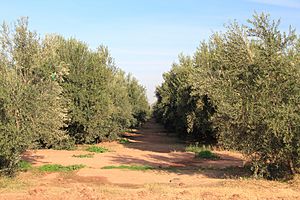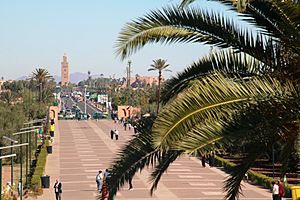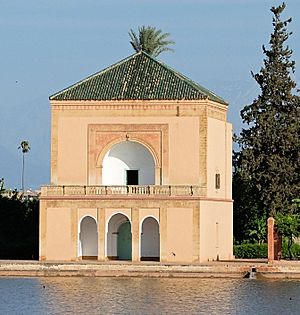Menara gardens facts for kids

Water reservoir and pavilion of the Menara
|
|
| Location | Marrakech, Morocco |
|---|---|
| Type | historic garden/orchard |
| Beginning date | 1157 CE |
The Menara Gardens (Arabic: حدائق المنارة) are a famous old public garden and orchard in Marrakech, Morocco. They were created in the 12th century, around the year 1157. This was done by Abd al-Mu'min, a ruler from the Almohad Caliphate.
These gardens, along with the Agdal Gardens and the old walled city of Marrakesh, are very important. They have been a UNESCO World Heritage Site since 1985. The gardens are built around a large water pool and reservoir. Next to this pool is a beautiful building called a pavilion. This pavilion, in its current look, was built in the 19th century. The reservoir and its pavilion are often seen in pictures with the High Atlas Mountains in the background. This view is a well-known symbol of Marrakesh.
Contents
What Does "Menara" Mean?
The exact meaning of the name Menara for these gardens is not fully known. The name first appeared in old writings in 1579. The Arabic word menara (منارَة) can mean "minaret" (a tall tower on a mosque), "lighthouse," or a "lantern/beacon."
Many people think the name refers to the two-story pavilion that stands by the main water reservoir. However, some historians believe the name might be much older, from the time of the Almohad rulers. They suggest it could refer to the minaret of the Kutubiyya Mosque. This mosque is to the northeast of the gardens. Its minaret was also started by Abd al-Mu'min, and the gardens are somewhat lined up with it.
A Look Back: History of the Gardens
The idea of building gardens outside the city walls started very early in Marrakesh. The Almoravid dynasty, who founded the city in 1070, built many gardens and large artificial lakes. These were called buḥā'ir, meaning "little sea," because of the big water basins. These garden areas continued to grow under the Almohads, who took over the city in the 12th century.
How the Menara Gardens Started
The Menara Gardens were first created by Abd al-Mu'min, the Almohad ruler, in 1157. Historians learned this from old stories that describe Abd al-Mu'min building a huge garden area west of the city. This area had two large water reservoirs. One of these is the main reservoir you see at the gardens today. The second reservoir was likely the Sahrij al-Bgar, which means "basin of the cows." It is located a short distance away from the Menara Gardens. This second basin is no longer used today. The entire large garden area was once surrounded by a 6-mile-long wall, which is now gone.
The gardens' location to the west of the city walls made sense. Abd al-Mu'min lived in the old Almoravid palace, near where the Kutubiyya Mosque is now. The gardens were perfectly lined up with Bab al-Makhzen, the western gate of the city, which he would have used.
An engineer from Malaga, named Hajj al-Ya'ish, likely designed the gardens. He also worked on other big projects for Abd al-Mu'min. One old story even says that the second water basin was used to teach ḥuffāẓ (people who memorized the Qur'an) how to swim!
Later Years and Restoration
The gardens and the city faced a tough time after the Almohads fell in the 13th century. The capital moved to Fez, and things declined. But when the Saadi Sultanate made Marrakesh the capital again in the 16th century, they restored the city's gardens. The Saadians were the first to build a pleasure pavilion overlooking the water.
The Menara Gardens look the way they do today thanks to the Alaouite dynasty sultans Moulay Abd ar-Rahman (who ruled from 1822–1859) and his son Muhammad IV (who ruled from 1859–1873). They worked to restore and replant both the Menara and Agdal gardens. Muhammad IV built the current pavilion on the remains of the old one, finishing it in 1870. Until the early 1900s, ostriches were even raised in the gardens. This was part of a long tradition of sultans using wild animals to impress visitors.
What You Can See: Description
Where Are the Gardens Located?
The Menara Gardens are on a flat area west of Marrakesh. They are outside the old city walls and very close to the Menara Airport. Today, they still have the large central water basin, the historic pavilion, and a very big orchard around them. The whole area is shaped like a rectangle, about 1200 meters long and 720 to 800 meters wide. The water reservoir itself is a rectangle, 195 meters long and 160 meters wide.
The Orchards and Their Purpose

Royal Moroccan gardens like the Menara were mostly for farming. Their purpose was to grow food, and being a place for fun came second. While we don't have many detailed studies, old texts tell us what was planted here. Throughout history, these gardens grew similar types of trees and crops, mainly fruit and olive trees. Today, the orchard still has mostly olive trees, along with some fruit trees and cypress trees. The trees are planted in neat rows, about 10 meters apart.
How the Gardens Get Water
The orchards are watered using a special irrigation system. This system needs regular care. If it was not maintained, the gardens could turn into desert. The large water basins were built to store a lot of water. This water could then be used to water the gardens all year, even when rivers were dry in winter.
Water was brought to the city and the gardens by a network of khettaras. These are ancient underground channels that tap into water from the nearby High Atlas Mountains. The Menara water reservoir is built above the ground. This allows the surrounding orchards, which are on lower ground, to be watered easily by gravity. There are stairs around the reservoir that lead to a walkway. At the bottom of the stairs on the northeast side, there is a small, pretty octagonal basin that used to be a fountain.
The Pavilion Building
The pavilion, built in the 19th century, is made of stone. It has a rectangular shape, two floors, and a green-tiled roof shaped like a pyramid. It is a great example of royal pavilion architecture from the Alaouite period in Morocco.
The first floor was used for daily activities. It has a large room with four strong pillars. There is also a triple-arched entrance area that sticks out to the north, opening onto the lake. Another entrance is on the south side. You reach the upper floor by a steep, straight staircase. This upper floor has a large square room. A low, rectangular door leads to a balcony on the north side, right above the ground-floor entrance. This low door might have been designed so people below couldn't easily see inside. The staircase also continues to the roof, where a smaller balcony on the south side offers views of the orchards and the Atlas Mountains. The pavilion is also inside its own small garden area, surrounded by another wall. This separates it from the rest of the public grounds.
The pavilion's decoration is simpler compared to older Moroccan buildings. On the outside, the corners and edges of the walls are painted to look like brickwork. Geometric shapes and writings are painted around the southern entrance and some windows. The door to the northern balcony has a large, rounded arch around it, with a special stone in the middle. The spaces next to the arch are painted with swirling arabesque designs. Above this, a narrow band has an Arabic inscription that includes the year the building was finished (1870 CE). All the painted decorations are in ochre colors on a layer of plaster. Inside, the rooms have painted lines that highlight the arched ceilings. There is also carved and painted stucco with Islamic geometric patterns around the windows and doors, and painted wood ceilings.
See Also
 In Spanish: Jardines de la Menara para niños
In Spanish: Jardines de la Menara para niños
- Buhaira Gardens
- Landmarks of Marrakesh










